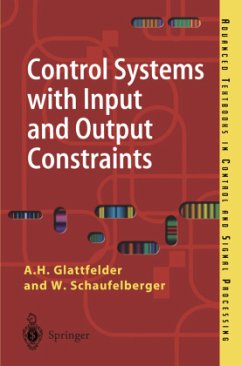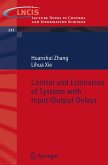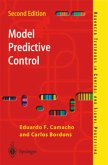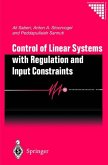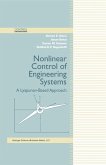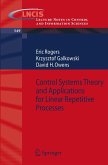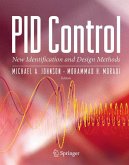A typical method of dealing with input and output constraints, especially for PID control, has been the empirical design and implementation of an intuitive solution to an individual plant and its constraints. Such ad hoc solutions perform surprisingly well but often remain in the form of isolated practical know-how without a more general scientific basis.
Control Systems with Input and Output Constraints develops this empirical approach by demonstrating how particular answers to particular industrial design problems can be systematized to cope with a wide variety of simple and more complex situations. Each class of design problems is presented in five parts: industrial situation; problem statement; currently available control structures; benchmark simulation to obtain typical transient response and nonlinear stability analysis to relate structure to response. Links to optimal control and model predictive control are also explored. These steps help the reader to learn how to choose or adapt a control architecture and design or analyse it on a systematic basis.
Features:
associated website contains many ready-made examples and case studies using Matlab"/Simulink" to which extensive reference is made throughout the text facilitating understanding and saving time;
exercises interspersed throughout each chapter that allow the student to confirm progress as he/she proceeds;
logical five-step design procedure for each problem class moving from a particular industrial example to the informed choice of generic controller and the preparation of closed loop analysis.
Control Systems with Input and Output Constraints will be of great benefit to advanced students of control looking to pursue a career in process and/or plant control or in applications-oriented research. The practical basis of the presentation, the systematic design procedure, the restraint on mathematical formalism and emphasis on implementability will also appeal to industrial control engineers.
Hinweis: Dieser Artikel kann nur an eine deutsche Lieferadresse ausgeliefert werden.
Control Systems with Input and Output Constraints develops this empirical approach by demonstrating how particular answers to particular industrial design problems can be systematized to cope with a wide variety of simple and more complex situations. Each class of design problems is presented in five parts: industrial situation; problem statement; currently available control structures; benchmark simulation to obtain typical transient response and nonlinear stability analysis to relate structure to response. Links to optimal control and model predictive control are also explored. These steps help the reader to learn how to choose or adapt a control architecture and design or analyse it on a systematic basis.
Features:
associated website contains many ready-made examples and case studies using Matlab"/Simulink" to which extensive reference is made throughout the text facilitating understanding and saving time;
exercises interspersed throughout each chapter that allow the student to confirm progress as he/she proceeds;
logical five-step design procedure for each problem class moving from a particular industrial example to the informed choice of generic controller and the preparation of closed loop analysis.
Control Systems with Input and Output Constraints will be of great benefit to advanced students of control looking to pursue a career in process and/or plant control or in applications-oriented research. The practical basis of the presentation, the systematic design procedure, the restraint on mathematical formalism and emphasis on implementability will also appeal to industrial control engineers.
Hinweis: Dieser Artikel kann nur an eine deutsche Lieferadresse ausgeliefert werden.
"The authors emphasize that they have taken an engineering approach instead of a mathematical approach in the book. This is true and it makes the book interesting not only for researchers in the field, but also for students that should learn about the problems and the solutions. To facilitate these studies, there is a website associated with the book where the Matlab/Simulink programs used in the examples are available. The book is also a valuable reference for engineers faced with implementation problems. The number of such engineers is large, and the number of control loops implemented poorly with respect to saturations and override control is large and increasing. Several of the dominating suppliers of instrument systems for process control deliver products where the anti-windup and override control works well for the simple feedback loop, but where the problems are unsolved, or solved in an erroneous way, when it comes to more complicated controller structures involving e.g. cascade couplings, feed-forward, and selectors. There is a need to improve the knowledge about these problems, and this book is one step on the way to achieve this. Professor Glattfelder and Professor Schaufelberger have been the leading experts in the area of control with constraints for a long time. They have now summarized their experience in the present book, and they have succeeded in their intention to produce the first reference in the area that will be available for a broad audience. I think that this book will be a standard reference for a long time."
-- Control Engineering Practice 13 (2005) 131 (Reviewer: Tore Hägglund)
"It is difficult to overstate the importance of considering control constraints in control system design: such constraints have well-known implications for the behaviour of the resulting closed-loop system, and ignoring these constraints can lead to a dramatic loss of performance and, potentially, stability... The subject of this review is the first and, so far, the only, book to address the topic of anti-windup compensation, and it is authored by two eminent authorities in the field. Professors Glattfelder and Schaufelberger are regular contribuotrs to the anti-windup literature and accomplished practical control engineers;... The book is essentially split into two parts: the first part covers PI control of dominant first order systems; the second part generalizes the concepts of the first to plants of higher order with more complex controllers and also lays the foundations for multivariable anti-windup/override control. An interesting feature of the book is the "inductive" approach which the authors adopt; rather than starting from a general treatment of the problem, the authors prefer to point out the key features of their ideas using relatively simple systems at first and then extend these ideas to more complex systems... Overall, this is a well-written and well-structured book in which the authors have devoted considerable attention to imparting their message to the reader in a simple and direct manner... After reading the book, one is left with the sense that the schemes described within the book are not purely abstract, but that they can be applied in practice with great benefit."
-- International Journal of Robust and Nonlinear Control 14 (2004) 1299 - 1300 (Reviewer: Matthew Turner)
"In Control Systems with Input and Output Constraints, the authors address control problems for linear plants ... . In Part I of the book, the authors begin their discussion of control with input constraints ... . The nice feature of Part I of the book is that it is targeted to an industrial audience and is written in a practically oriented style ... . Part II can be seen as an interesting overview of recent advanced techniques for more complicated problem settings."
-- IEEE Control Systems Magazine June (2005) 96 - 99 (Reviewers: Andrew R. Teel and L. Zaccarian)
"A typical method of dealing with input and output constraints, especially for PID control, has been the empirical design and implementation of an intuitive solution to an individual plant and its constraints. ... Control Systems with Input and Output Constraints develops this empirical approach ... . The practical basis of the presentation, the systematic design procedure, the restraint on mathematical formalism ... will also appeal to industrial control engineers. Written for graduate students in control engineering, academic researchers in control engineering ..."
-- Automatisierungstechnische Praxis ATP 45/12 (2003)
"This book familiarizes the reader with PID control design methodologies when the inputs and/or outputs can saturate. The authors present their topics in an inductive manner from simple cases to more complicated ones, but they do not loose themselves in this way. The text is well structured. ... The book is of interest to engineers and students in control system design.
-- Zentralblatt MATH 1030 (2004) (Reviewer: A. Akutowicz)
-- Control Engineering Practice 13 (2005) 131 (Reviewer: Tore Hägglund)
"It is difficult to overstate the importance of considering control constraints in control system design: such constraints have well-known implications for the behaviour of the resulting closed-loop system, and ignoring these constraints can lead to a dramatic loss of performance and, potentially, stability... The subject of this review is the first and, so far, the only, book to address the topic of anti-windup compensation, and it is authored by two eminent authorities in the field. Professors Glattfelder and Schaufelberger are regular contribuotrs to the anti-windup literature and accomplished practical control engineers;... The book is essentially split into two parts: the first part covers PI control of dominant first order systems; the second part generalizes the concepts of the first to plants of higher order with more complex controllers and also lays the foundations for multivariable anti-windup/override control. An interesting feature of the book is the "inductive" approach which the authors adopt; rather than starting from a general treatment of the problem, the authors prefer to point out the key features of their ideas using relatively simple systems at first and then extend these ideas to more complex systems... Overall, this is a well-written and well-structured book in which the authors have devoted considerable attention to imparting their message to the reader in a simple and direct manner... After reading the book, one is left with the sense that the schemes described within the book are not purely abstract, but that they can be applied in practice with great benefit."
-- International Journal of Robust and Nonlinear Control 14 (2004) 1299 - 1300 (Reviewer: Matthew Turner)
"In Control Systems with Input and Output Constraints, the authors address control problems for linear plants ... . In Part I of the book, the authors begin their discussion of control with input constraints ... . The nice feature of Part I of the book is that it is targeted to an industrial audience and is written in a practically oriented style ... . Part II can be seen as an interesting overview of recent advanced techniques for more complicated problem settings."
-- IEEE Control Systems Magazine June (2005) 96 - 99 (Reviewers: Andrew R. Teel and L. Zaccarian)
"A typical method of dealing with input and output constraints, especially for PID control, has been the empirical design and implementation of an intuitive solution to an individual plant and its constraints. ... Control Systems with Input and Output Constraints develops this empirical approach ... . The practical basis of the presentation, the systematic design procedure, the restraint on mathematical formalism ... will also appeal to industrial control engineers. Written for graduate students in control engineering, academic researchers in control engineering ..."
-- Automatisierungstechnische Praxis ATP 45/12 (2003)
"This book familiarizes the reader with PID control design methodologies when the inputs and/or outputs can saturate. The authors present their topics in an inductive manner from simple cases to more complicated ones, but they do not loose themselves in this way. The text is well structured. ... The book is of interest to engineers and students in control system design.
-- Zentralblatt MATH 1030 (2004) (Reviewer: A. Akutowicz)
From the reviews:
The authors emphasize that they have taken an engineering approach instead of a mathematical approach in the book. This is true and it makes the book interesting not only for researchers in the field, but also for students that should learn about the problems and the solutions. To facilitate these studies, there is a website associated with the book where the Matlab/Simulink programs used in the examples are available.
The book is also a valuable reference for engineers faced with implementation problems. The number of such engineers is large, and the number of control loops implemented poorly with respect to saturations and override control is large and increasing. Several of the dominating suppliers of instrument systems for process control deliver products where the anti-windup and override control works well for the simple feedback loop, but where the problems are unsolved, or solved in an erroneous way, when it comes to more complicated controller structures involving e.g. cascade couplings, feed-forward, and selectors. There is a need to improve the knowledge about these problems, and this book is one step on the way to achieve this.
Professor Glattfelder and Professor Schaufelberger have been the leading experts in the area of control with constraints for a long time. They have now summarized their experience in the present book, and they have succeeded in their intention to produce the first reference in the area that will be available for a broad audience. I think that this book will be a standard reference for a long time.
Control Engineering Practice 13 (2005) 131 (Reviewer: Tore Hägglund)
It is difficult to overstate the importance of considering control constraints in control system design: such constraints have well-known implications for the behaviour of the resulting closed-loop system, and ignoring these constraints can lead to a dramatic loss of performance and,potentially, stability...
The subject of this review is the first and, so far, the only, book to address the topic of anti-windup compensation, and it is authored by two eminent authorities in the field. Professors Glattfelder and Schaufelberger are regular contribuotrs to the anti-windup literature and accomplished practical control engineers;...
The book is essentially split into two parts: the first part covers PI control of dominant first order systems; the second part generalizes the concepts of the first to plants of higher order with more complex controllers and also lays the foundations for multivariable anti-windup/override control.
An interesting feature of the book is the "inductive" approach which the authors adopt; rather than starting from a general treatment of the problem, the authors prefer to point out the key features of their ideas using relatively simple systems at first and then extend these ideas to more complex systems...
Overall, this is a well-written and well-structured book in which the authors have devoted considerable attention to imparting their message to the reader in a simple and direct manner... After reading the book, one is left with the sense that the schemes described within the book are not purely abstract, but that they can be applied in practice with great benefit.
International Journal of Robust and Nonlinear Control 14 (2004) 1299 - 1300 (Reviewer: Matthew Turner)
In Control Systems with Input and Output Constraints, the authors address control problems for linear plants ... . In Part I of the book, the authors begin their discussion of control with input constraints ... . The nice feature of Part I of the book is that it is targeted to an industrial audience and is written in a practically oriented style ... . Part II can be seen as an interesting overview of recent advanced techniques for more complicated problem settings.
IEEEControl Systems Magazine June (2005) 96 - 99 (Reviewers: Andrew R. Teel and L. Zaccarian)
A typical method of dealing with input and output constraints, especially for PID control, has been the empirical design and implementation of an intuitive solution to an individual plant and its constraints. ... Control Systems with Input and Output Constraints develops this empirical approach ... . The practical basis of the presentation, the systematic design procedure, the restraint on mathematical formalism ... will also appeal to industrial control engineers. Written for graduate students in control engineering, academic researchers in control engineering ... .
Automatisierungstechnische Praxis ATP 45/12 (2003)
"This book familiarizes the reader with PID control design methodologies when the inputs and/or outputs can saturate. The authors present their topics in an inductive manner from simple cases to more complicated ones, but they do not loose themselves in this way. The text is well structured. ... The book is of interest to engineers and students in control system design.
Zentralblatt MATH 1030 (2004) (Reviewer: A. Akutowicz)
The authors emphasize that they have taken an engineering approach instead of a mathematical approach in the book. This is true and it makes the book interesting not only for researchers in the field, but also for students that should learn about the problems and the solutions. To facilitate these studies, there is a website associated with the book where the Matlab/Simulink programs used in the examples are available.
The book is also a valuable reference for engineers faced with implementation problems. The number of such engineers is large, and the number of control loops implemented poorly with respect to saturations and override control is large and increasing. Several of the dominating suppliers of instrument systems for process control deliver products where the anti-windup and override control works well for the simple feedback loop, but where the problems are unsolved, or solved in an erroneous way, when it comes to more complicated controller structures involving e.g. cascade couplings, feed-forward, and selectors. There is a need to improve the knowledge about these problems, and this book is one step on the way to achieve this.
Professor Glattfelder and Professor Schaufelberger have been the leading experts in the area of control with constraints for a long time. They have now summarized their experience in the present book, and they have succeeded in their intention to produce the first reference in the area that will be available for a broad audience. I think that this book will be a standard reference for a long time.
Control Engineering Practice 13 (2005) 131 (Reviewer: Tore Hägglund)
It is difficult to overstate the importance of considering control constraints in control system design: such constraints have well-known implications for the behaviour of the resulting closed-loop system, and ignoring these constraints can lead to a dramatic loss of performance and,potentially, stability...
The subject of this review is the first and, so far, the only, book to address the topic of anti-windup compensation, and it is authored by two eminent authorities in the field. Professors Glattfelder and Schaufelberger are regular contribuotrs to the anti-windup literature and accomplished practical control engineers;...
The book is essentially split into two parts: the first part covers PI control of dominant first order systems; the second part generalizes the concepts of the first to plants of higher order with more complex controllers and also lays the foundations for multivariable anti-windup/override control.
An interesting feature of the book is the "inductive" approach which the authors adopt; rather than starting from a general treatment of the problem, the authors prefer to point out the key features of their ideas using relatively simple systems at first and then extend these ideas to more complex systems...
Overall, this is a well-written and well-structured book in which the authors have devoted considerable attention to imparting their message to the reader in a simple and direct manner... After reading the book, one is left with the sense that the schemes described within the book are not purely abstract, but that they can be applied in practice with great benefit.
International Journal of Robust and Nonlinear Control 14 (2004) 1299 - 1300 (Reviewer: Matthew Turner)
In Control Systems with Input and Output Constraints, the authors address control problems for linear plants ... . In Part I of the book, the authors begin their discussion of control with input constraints ... . The nice feature of Part I of the book is that it is targeted to an industrial audience and is written in a practically oriented style ... . Part II can be seen as an interesting overview of recent advanced techniques for more complicated problem settings.
IEEEControl Systems Magazine June (2005) 96 - 99 (Reviewers: Andrew R. Teel and L. Zaccarian)
A typical method of dealing with input and output constraints, especially for PID control, has been the empirical design and implementation of an intuitive solution to an individual plant and its constraints. ... Control Systems with Input and Output Constraints develops this empirical approach ... . The practical basis of the presentation, the systematic design procedure, the restraint on mathematical formalism ... will also appeal to industrial control engineers. Written for graduate students in control engineering, academic researchers in control engineering ... .
Automatisierungstechnische Praxis ATP 45/12 (2003)
"This book familiarizes the reader with PID control design methodologies when the inputs and/or outputs can saturate. The authors present their topics in an inductive manner from simple cases to more complicated ones, but they do not loose themselves in this way. The text is well structured. ... The book is of interest to engineers and students in control system design.
Zentralblatt MATH 1030 (2004) (Reviewer: A. Akutowicz)

